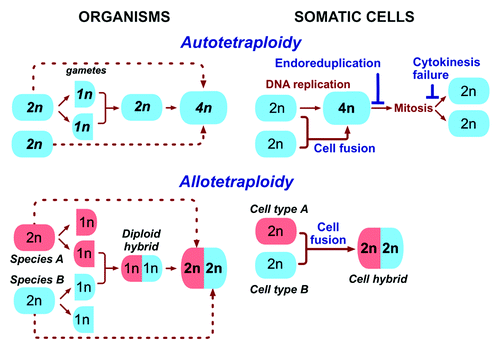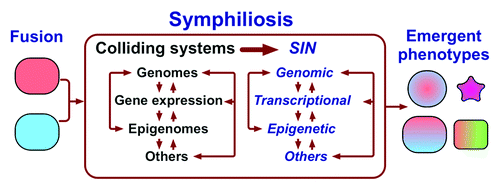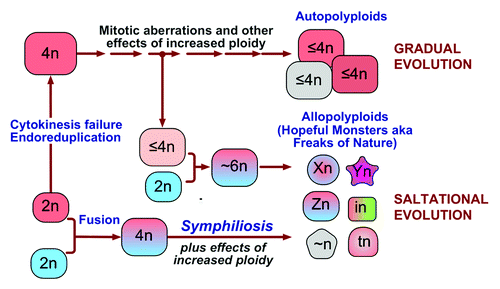Figures & data
Figure 1. The pathways to tetraploidy in the evolution of species and somatic cells. Autotetraploid organisms result from whole genome duplication occurring either by doubling the genome of the zygote, or by the fusion of non-reduced gametes (dotted lines). Allotetraploid organisms are created by the fusion of gametes from different species with the subsequent duplication of the genome, or by fusion of non-reduced gametes (dotted lines). In somatic cells, tetraploidy is caused by either whole genome duplication (top panel), which can result from endoreduplication, cytokinesis failure, and fusion of identical cells, or by fusion that combines different cells (bottom panel). Note (dotted lines) that allopolyploids can be made by fusing somatic plant cells (protoplasts) in vitro and letting the resulting hybrids to develop into plants. 1n, 2n and 4n indicate haploid, diploid and tetraploid number of chromosomes.

Figure 2. Fusion of different cells causes the collision of merged cellular systems, resulting in death or leading to symphiliosis, or reconciliation. Symphiliosis is manifested by interrelated instabilities summarily named symphilial instabilities (SIN) that are a result of integrating distinct sets of parental networks into one. Symphiliosis can produce emergent phenotypes, cause death, senescence, or continue permanently. “Other” systems can include mitochondria, which have their own genome, and interactions with other cells to give just two examples.

Figure 3. A model: The pathways to polyploidy have different roles in the evolution of neoplastic cells. To use plant terminology, cytokinesis failure and endoreduplication produce autopolyploid cells that are affected by mitotic aberrations and other consequences of increased ploidy, resulting in gradual evolution of the cells. Fusion of different cells results in allopolyploids, thus suddenly, within one generation, producing clones with emergent phenotypes and enabling saltational evolution. Cells of any ploidy can fuse, thus increasing the diversity of allopolyploids.

